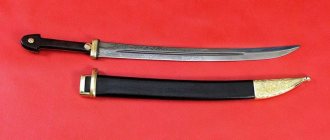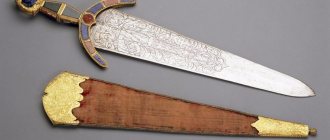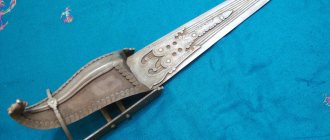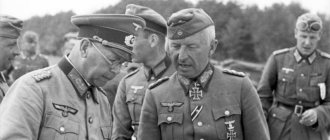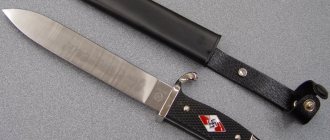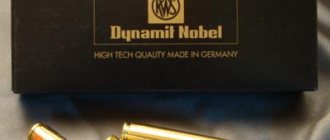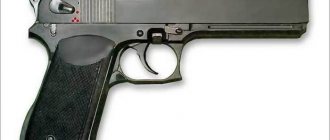Nowadays, the combat knives in service with the special services bear little resemblance to their historical counterparts. For example, in Russia the most famous combat knife today is the bayonet for the Kalashnikov assault rifle. If you ask people on the street to remember any other famous blades used in the army, then some might name a straight Caucasian dagger. But you can be sure that its name will be remembered only in the Caucasus or Cossacks.
Today we will tell you about another combat dagger - the bebuta. Before the revolution, this curved blade was very common in the tsarist army, but then they forgot about it. It remained a relic of past times, stopping its development immediately after the revolution.
Where did such weapons come from?
Curved blades usually came to Russia from the East. Bebut is an oriental type dagger with a long blade curved closer to the tip. The name of the dagger comes from the word “bek”, which means “thigh” in the Turkic language. For the first time, these weapons “lit up” in the Caucasus, since local residents traditionally had close ties with the Ottoman Empire and the entire East.
The mountaineers quickly appreciated the advantages of the curved bebut, which could be used to cut effectively in confined spaces or crowds. Soon the Russian officers realized that they were making very effective weapons. The mountaineers quickly noticed that the Russian soldiers did not have blades and skillfully used this. They put on chain mail and, having dispersed their horse, crashed into Russian soldiers armed with rifles. In the crowd, a mountaineer dismounted and began to chop with a bebut. Soldiers in close quarters could not be shot or stabbed with bayonets, so brave warriors often retreated after the battle unharmed, leaving behind several corpses and a bunch of wounded.
You should not think that the bebut attracted the attention of all military officials in Russia, but many used it, from the Cossacks to the artillerymen. Therefore, the high command decided that the curved dagger was worthy of becoming the official edged weapon of the Russian army.
Bebut today
The solid weight of the blade implies serious striking force. They can deliver slashing and piercing blows - the curved shape is not a hindrance to this. Moreover, it enhances the power of the slash.
Today it is problematic to buy such a weapon, but there are many replicas of Bebut from various manufacturers. But you can legally store it at home and even carry it with you if the model is not sharpened.
Previous
Combat knivesBallistic knife that shoots blades
Next
Kitchen knivesThe best chef's knives: rating of universal kitchen cutters
The history of the appearance of bebuta in the army
In 1902, Russian artillerymen received the latest guns, characterized by high firing speed. Now the gun crews had to work at a more intensive pace, and the authorized saber turned out to be too bulky and inconvenient weapon. To be honest, artillerymen were never considered good fighters, so the opportunity to obtain new bladed weapons was greeted with enthusiasm by them. Well, now the blade will not get underfoot and interfere with loading the guns.
A special commission was created to consider the issue of replacing the artillery checker. Although everyone understood perfectly well that the artillerymen did not know how to cut, and if the enemy broke through to the guns, nothing would save them, psychologically the soldiers felt more protected with cold steel in their hands. Of the 30 commission members, only 5 people spoke out against replacing checkers with bebuts. They argued that the Russians did not know how to wield daggers, and that it was more important for artillerymen to have a universal weapon capable of digging.
As an alternative, they proposed giving the artillerymen an ax or cleaver. But the bebut really had real combat power, which was demonstrated in tests. It cut perfectly, and thanks to its slight bend, it could be used to stab effectively.
In 1907, the gendarmerie received bebouts. Only the sergeants had checkers. A year later, such daggers appeared among machine gunners. Only in 1909 did artillerymen receive curved daggers. In 1910, mounted scouts were armed with bebuts.
In 1910, the gendarmerie again received checkers, and the bebuts were taken away from them. But the Cossacks, who were the best in the Russian army to wield these weapons, did not receive them. Despite this, they were not prohibited from purchasing and carrying curved daggers. The officers found themselves in the same position. Bebuts were especially loved by cavalry officers, who managed to evaluate their effectiveness during the wars in the Caucasus. They also bought Persian curved daggers with their own money, and sometimes used them in battle.
Bebut in the Russian army
The weapon was initially for personal use only by senior officers.
The Cossack Bebut came to the Russian army in 1907. At this time, the need arose for additional weapons to replace the authorized artillery saber. It turned out to be more convenient to wield a bebut knife than a saber, and besides, its shape is much more convenient.
In the early years, only the highest ranks were armed with bebuts, but starting in 1909, the artillery bebut became available to all military personnel. Despite the lack of a tradition of using daggers in the Russian army, the curved blade quickly became an indispensable part of the weapon.
Statutory bebut of 1907
The bebut has a length of 600 mm, of which the blade accounts for up to 440 mm, it is curved, with fullers. The handle is figured, with wooden overlays. They are held in place by brass rivets. At the top of the handle there is a forging made of the same brass.
The scabbard was made of wood, covered with wax wax, and the scabbard was made of metal. The weight of the dagger could reach 750 grams. Bebuts of the 1907 model were produced at several Russian factories, including Izhevsk, Zlatoust and Artinsky. Since the weapon was intended for junior military ranks, there were no decorations on it.
After the revolution, some Red Army soldiers wore bebuts; some photographs show that Latvian riflemen also did not disdain these blades.
Origin of the dagger
Curved blades are the calling card of the East. And the bebut is no exception, since it was originally a traditional Caucasian dagger. The name of the blade “bebut” comes from the Turkic word, translated meaning “thigh”.
It is difficult to say when the history of this dagger began. It became widespread only at the beginning of the twentieth century, when it became part of the weapons of the Russian army. Presumably, the “ancestor” of a blade of this shape is a curved Persian or Ottoman dagger.
At the end of the 19th century, the bebut dagger was in use among the Cossacks. If everyone without exception was armed with a flat dagger, the curved blade was chosen by plastuns, since the thin and long blade ensured the convenience of carrying edged weapons in any situation.
Officially, the bebut has been known since 1840, as part of the uniform of the Kuban Cossacks, but its history is much older. In general, previously a bebut was called any dagger with a curved blade at the end, while now this name refers to the “Bebut” of the 1907 model.
What can you say about Bebuta?
The impact force with such a weight is very serious, although the handle seems too thin, it fits perfectly in the palm. You can deliver piercing blows with a dagger; a slight curvature does not interfere with this at all. The blade is heavier than a straight kama, so the chopping blows are much stronger, which is also facilitated by the curved shape.
The only negative is that the bebut is a bladed weapon, which means you cannot carry it, and it will be problematic to buy. On the other hand, no one forbids purchasing unsharpened models that you can carry with you. If you really want to, you can sharpen it, only then can it be equated to making chemical weapons, but who will know about this? Keeping even a sharpened dagger at home is not illegal.
It is a pity that they did not revive the bebut in the 21st century in the same way as they did with the Cossack Plastun knife. It could have been modified a little, designed as a household item, like a machete. I'm sure it would beat out the big survival knives in the knife markets.
Bebout, “a curved soldier’s dagger of the 1907 model.”
Bebut (Persian behbūd from Turkic bekbut (bek + but (leg, thigh)) is one of the main (along with KAMA) types of Caucasian daggers. When pronouncing the word, the emphasis is on the letter “e”.
Bebut, came to replace the artillery checker, which prevented the crew from firing from the new rapid-fire guns that had been entering the army since 1902.
Also, according to the doctrine, the possibility of conducting hand-to-hand combat in trenches and communication passages was taken into account. Its length made it possible to confidently use the dagger when chopping. The slight curvature did not interfere with piercing actions. The double-edged nature of the blade and the symmetry of the handle made it possible to perform cutting and secting actions with different grips.
In 1907, Bebout was adopted by the gendarmerie (except for sergeants). In 1908 - adopted for the lower ranks of machine gun teams In 1909 - for all lower ranks of artillery troops, except for horse and horse-mountain artillery (by order of the Military Department No. 187 of May 17, 1909) In 1910, the Bebut dagger was adopted for use by the lower ranks of mounted reconnaissance infantry regiments. Since 1910, bebuts were again replaced by checkers among the lower ranks of the gendarmes. During the 1st World War, a simplified version of the dagger with a straight blade was made for the same units.
DIAGRAM drawing of the so-called “black bebut” - in the drawing the scabbard is made of iron! This metal scabbard was supposed to be painted black. It is not known whether the “black bebut” was released (at least as an experimental batch) or remained on paper. But among collectors, the “black bebut” is like the Sioux bird from the Strugatskys - an unattainable dream - it exists, but you cannot see it. Because it is a special bird!
TTX:
Manufacturer: Zlatoust Arms Factory. The blade is slightly curved, steel, with two fullers on each side.
The handle is shaped, made of wood, narrowed in the middle part. consists of cheeks secured with two rivets. The top rivet also holds the metal sleeve in place.
Scabbard - Wooden, painted black or covered with leather, has a metal device consisting of a mouth, a bracket with a ring and a tip. The number of the military unit was stamped on the sleeve of the handle and scabbard.
The blade is slightly curvature, double-edged, with two narrow fullers and a tang that forms the shape of a handle. The hilt consists only of a handle. The handle is figured, narrow in the middle part, wooden parts are placed on the shank of the blade and connected using a brass figured bushing and two rivets with convex buttons in the upper and lower (passes through the bushing) parts of the handle. The handle is painted black. There is a leather pad on the edge of the handle.
Scheme drawing of Bebout
Characteristics of the soldier's dagger (bebut) model 1907: Total length, mm: up to 600; Blade length, mm: about 440; Blade width, mm: 35 Weight, g: up to 750
Some information provided by the source: https://panzer038.livejournal.com/1497926.html
The Bebut soldier's dagger was in service with the Russian Imperial Army until the 1917 revolution. By decision of the congress of heads of external security departments of the KVD KSSO, from August 13, 1918, “Bebut” was in service with foot police officers (revolutionary guards), mounted officers were armed with a saber, and also had limited use in the infantry units of the Red Army.
The curved artillery dagger BEBUT was originally produced at the Zlatoust arms factory ZOF and had a handle with two dies “cheeks” made of unpainted birch, which were attached to the figured shank of the blade using two rivets with small hemispherical brass caps - “buttons”. The iron stems of the rivets on the back of the handle were riveted directly on the wood, which often caused cracking of the handle and ultimately led to its modernization - in 1911, the heads of the rivets were enlarged, a figured handle-ring and a washer appeared on the back of the handle. There were the following marks - Golomen of the blade on the left: A stylized image of the Russian double-headed eagle and the inscription in a circle “Zlatoust Or.Fab” were applied - the mark of the manufacturer - the Zlatoust arms factory, and the year of manufacture of the dagger. Holomen of the blade on the right: “A” and “A” under the crown are inspector acceptance marks meaning: “A” acceptance of the blade separately and acceptance of the dagger assembly - “A under the crown” (A is the initial letter of the surname of the ZOF staff art acceptor Boris Vikentievich Alekseev) .
In addition to the ZOF, the arms factory in the city of Artinsk was also producing blades for Bebut daggers.
At Arti they only forged bare blades and sent them to ZOF for subsequent full inspection and final assembly. Therefore, the marks on the brass parts of the device are ZOFovsky, and the blade has a stylized image of the Russian double-headed eagle on the left side of the blade and the inscription in a circle “Artinsky Zav. “—the mark of the manufacturer - the Artinsky plant and the year the dagger was made. On the right holomen there are the same acceptance marks as on the ZOF blades. It is interesting that early editions of Artin bebuts were equipped with rivets with a large button.
Later issues are assembled using rivets with a small button of the early, first type of ZOF. Apparently, the decision to use unspent reserves of small rivets for assembling bebuts from the “subsidiary branch” was made at ZOF in wartime due to a shortage of components.
Initially, the blades of the Izhevsk bebuts, like the ZOF blades, were forged from crucible steel. However, later, in order to increase the number of blades produced, rolled open-hearth steel began to be used for their manufacture - these blades were in no way inferior in quality to forged ones. The blade is slightly curved, steel, double-edged, with two narrow fullers on both sides. The surface of the blade is in good condition with slight temporary patina, with well-preserved factory sharpening and marks. The scabbard is wooden, covered with black leather, which is varnished, which is one of the distinctive features of Izhevsk production. The sheath device is brass, consists of a mouth with a bracket and a ring for a belt loop and a tip with a ball secured to the sheath with a brass bracket. It was noticed that the “elaboration” of all brass parts at the Izhevsk plant was carried out to a lesser quality than at ZOF. Izhevsk stamp - an image of a bow and arrow and the capital letter “P” or “bow and star” are on all brass parts of the scabbard device.
Marks on the blade - Golomen of the blade on the left: On the Izhevsk bebuts, the year of manufacture of the dagger was not indicated. Only the mark of the manufacturer is applied - the Izhevsk plant - this is an image of a bow and arrow.
Verification stamps - a capital letter “P” and a smaller “P” - by analogy with the ZOF stamps - “Accepted as assembled” and “accepted”. The handle is Caucasian in shape, with two cheeks “dies” made of birch and etched with black varnish or painted with black paint according to the method of attachment to the handle’s shank, similar to the ZOF and ARTinsky bebuts. Since 1914, a special leather suspension - a blade - began to be used to carry a dagger. Many collectors and connoisseurs of Russian edged weapons agree that the bebut is a masterpiece of Russian weapons thought, since it has no analogues in world practice.
Continuation of the topic about Bebut-Kolchak
The main facts are presented based on the book by Yu.P. Okuntsov "Zlatoust Arms Factory". Excerpts - from chapter 13 - “Weapons production during the civil war”: “.... The Bolsheviks, in the conditions of the civil war, had no time for production. On June 25, 1918, the Reds left the city and units of the Czechoslovak corps entered it. The Zlatoust factory operated despite the change of government; moreover, with the arrival of the whites, it could count on the resumption of orders. Which is what happened soon. Mining chief G.I. Bolstrem received the order: “The production of shells and bladed weapons is extremely necessary for the Siberian government”... Until the end of 1918, the arms factory supplied the White Army with 12,000 dragoon sabers and over 3,000 bebuts. On February 12, 1919, the train of the Supreme Ruler of Russia arrived at Zlatoust station. Admiral Alexander Vasilyevich Kolchak visited the ZOF, noted the good work of the factory and promised his support “to everyone who, through hard work, makes the hard work of the army easier and helps the revival of the Motherland.” ZOF, like a number of other factories of military importance, was planned by the white command to be evacuated to Siberia in the event of a retreat. In June 1919, when the strategic initiative passed into the hands of the Reds, preparatory measures began for the evacuation of production. The evacuation took place in an orderly manner, and by the end of the summer of 1919, the main personnel, supplies and equipment were concentrated at their destination - the city of Tomsk. To house the arms factory, the factory of the manufacturer Kalinovsky was rented for 300,000 rubles in gold. The actual assembly of weapons was carried out in the workshops of the Polytechnic Institute. In Zlatoust itself, the production of bladed weapons was also restored, but for the Red Army. It should be noted that the situation at the plant under the leadership of the Bolsheviks was dire.
Complete anarchy - since the remaining workers did not believe in the prospect of payment for their work and held rallies more than worked. Everything was greatly complicated by the fact that the most disciplined and qualified workers, as well as all the engineers, craftsmen and technicians who supported production, left for evacuation. Without equipment and proper personnel, it was impossible to establish normal operation of the factory. Therefore, old deposits of defective blade blanks were used in order to “do at least something” for the Red Army. The year of manufacture and the factory mark on the blades were present, but the military acceptance marks were not placed, since the ZOF staff art acceptor, Colonel B.V. Alekseev, was in Tomsk - (later, in 1920, after returning from evacuation, Colonel Alekseev Boris Vikentievich was arrested and shot by the Cheka, in Zlatoust). However, in Tomsk itself at that time, the production of weapons also took place with great difficulties and was mainly carried out by assembling blanks taken from the ZOF, and when they ran out, what could be made right on the spot from suitable materials was used. Marks on weapons manufactured by the ZOF during evacuation continued to be placed in accordance with the rules adopted before 1917. A unique situation arose, which was only possible during the Civil War, when nominally the same factory simultaneously produced weapons for both the Red and White armies and when factory marks cannot be a reliable sign of a “red” or “white” ZOF.
There is another type of bebut and also at the level of legend. But supported by documents. This is the “White Bebut” - the fact is that the first “signal” batch of bebuts was produced with a device not made of brass but of “white metal” (most likely from “nickel silver” (nickel silver). But not a single such bebut has survived to this day...
In the photo there is a Statutory dagger-bebut of the 1907 model, issued in Tomsk.
A statutory dagger-bebut of the 1907 model,
issued in Tomsk, in 1919, at the ZOF in evacuation for the army of the Supreme Ruler of Russia, Admiral Kolchak. Open hearth steel blade, forged, curved, double-edged, with two narrow fullers on both sides. The factory sharpening has been partially preserved. The entire surface of the blade is covered with marks and other traces of use. The handle is Caucasian in shape, with two unpainted birch cheeks, which are attached to the figured shank of the blade using two rivets with hemispherical brass caps - “buttons”, the iron stems of which are on the back of the handle riveted on the original brass washer and eye of the ersatz-forging made of black iron and covering the lower part of the handle. The scabbard is wooden, covered with black leather, which is typical for ZOF products. The device is a factory-made ersatz scabbard - made entirely of iron, consisting of a stamped round mouth secured to the scabbard with a screw, without an eye for carrying a dagger, and of a tip with something like a ball at the end, secured to the scabbard with an iron bracket. An extremely rare specimen.
Thank you for the interesting information provided - dear Andrey.
The exhibit is located in
State Museum-Reserve Tsarskoe Selo in the Sovereign Martial Chamber
, the first museum in modern Russia dedicated to the First World War. GMZ "Tsarskoe Selo" 196601 St. Petersburg, Pushkin, st. Sadovaya, building 7 Fax [email protected]
Special thanks for support and assistance: Director of the museum - Olga Vladislavovna Taratynova
Deputy Director for Scientific and Educational Work -
Bott Iraida Kurtovna
Responsible Curator of the exhibition “Russia in the Great War” in the Military Chamber -
Onoprienko Nikolai Ivanovich
Curator of the Weapons Fund of the Tsarskoye Selo State Museum -
Gleb Viktorovich Arlyuk
